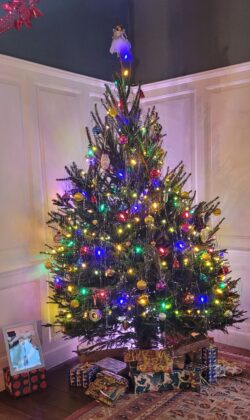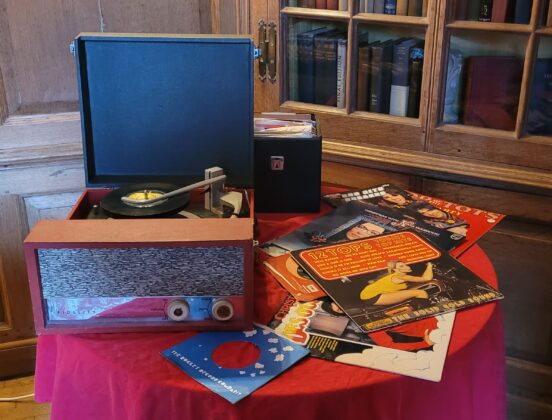Amongst the illustrious literary inhabitants of Lamb House was the prolific author Rumer Godden who lived there from 1967 to 1974. Having spent much of her life in India, Godden set her most well-known novels, including Black Narcissus, and The River, there. She has also written some of the 20th century’s best-loved children’s books including The Dolls’ House, (1947) The Greengage Summer (1957) and, whilst living at Lamb House, The Diddakoi, written in 1972 which won the first ever Whitbread Children’s Book Award.
This year’s theme for decorating Lamb House at Christmas has been inspired by Rumer Godden’s time there as well as by her 1956 children’s book The Fairy Doll. At Lamb House she was visited by her four grandchildren Mark, Elizabeth, Emma and Charlotte for Christmas while their parents were looking for a home in Scotland. Using family photographs and Godden’s descriptions of the grandchildren’s visit, the National Trust have recreated the feel of the 1970s and, as Rumer Godden wrote, a house that was “alive with those shrill, sometimes piercing child voices, scampering of feet – thumping of feet. There was sliding down the bannisters, toys left on the stairs, a new untidiness, a quickening of life…”.
A visit to Lamb House this Christmas (open from November 27 to December 20 excluding Thursdays) is, for many visitors, a trip down memory lane with people poring over the many familiar objects from the 60s and 70s that fill the rooms. The cries of “I had one of those as a child” or “That was in my grandmother’s house” can be heard rippling around the different rooms as people are caught up in the nostalgia.
The reception hall is decorated with 1970s colourful tinsel and a tree dressed with Christmas decorations reminiscent of the period. The Oak Parlour is a cosy room full of crocheted rugs, a drinks trolley with the obligatory advocaat bottle (that makes the classic snowball cocktail), Babycham glasses and a period Quality Street tin. A record player is in the corner alongside the Top of the Pops LPs that almost every household with children would have had.

Each room uses a family photograph and recreates it using similar objects or by reflecting the spirit of the photograph. A nativity scene is on the windowsill on the stairs, almost exactly replicating the family one seen in a photo nearby. The small dressing room upstairs is used as a playroom with a puppet theatre similar to the one seen in the photograph accompanying it. There are dolls and toys that many will recognise and will enjoy seeing again.
The lived-in feel of a busy family home is conveyed through the many period details: Blue Peter, Rupert Bear and Camberwick Green annuals are littered about the house along with abandoned toys strewn on the staircase. In the dining room, with its William Morris tablecloth (in typical 70s brown and orange shades), it is as if Rumer Godden has just left in the middle of planning the Christmas meal menus, using Fanny Cradock cookery books and Robert Carrier Cook Box recipe cards. The Georgian nightgown that is usually laid on the bed in the King’s Room is replaced with a wonderfully bright dress draped on a purple and lilac flowery bedspread.

The Green Parlour has been converted into an activity room where visitors can take part in different creative projects including a community art project making wax paper, stained glass windows panels (on December 2), and making decoupage Christmas cards (December 8).
As well as enjoying stepping back in time, there is a Fairy Doll Trail where children are challenged to find the Fairy Dolls hidden around the house and so solve the clues. On Saturdays December 2, 9 and 16, The Fairy Doll Storybook Hour takes place in the Breakfast Room with a reading of the story of Elizabeth, who is always getting into trouble, and the magical Fairy Doll who helps her.
It really is a wonderful visit, that harks back to Christmases past, and is a rare chance to see Lamb House in a completely different light.
Image Credits: National Trust/Cassie Dickson , National Trust/Juliet Duff .












